For those interested in more details regarding Winterlude’s stainless security bars, we had our stainless steel bars fabricated in the Rio Dulce, Guatemala by The Shop – I don’t think they’re there anymore, but they did a great job. Before we left the U.S. to go cruising, we tried to get the fabricator who did our arch to do safety bars, but he flat refused, saying we’d have a much greater risk of fire aboard and not being able to get out than any risk of someone trying to break in.
After being Robbed in Utila we went back to the Rio for hurricane season, looked at some other cruiser installations and had Chris design and fabricate these bars. They are NOT perfect – we feel like if anyone really really wants in, they’ll get in, no matter what safety measures we’ve taken. Luckily crime against cruisers is rare and most is opportunity theft — if the next boat is an easier target, they’ll skip your boat & move on. Unfortunately, that late afternoon/early evening in Utila, we were the ones that left them the opportunity. 🙁
Click on any of the photos below to see them slightly larger.

The stainless pegs are just epoxied in to the wooden frame. A backing plate would have made them more secure, but alot more work … going back to our theory of “if they’re determined to get it, they’ll get in, the bars are a deterrent” to opportunity theft.
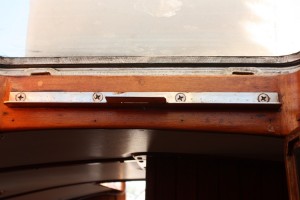

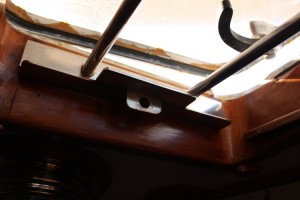
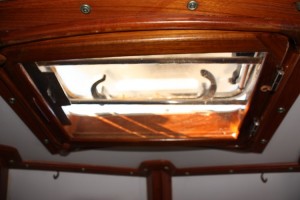
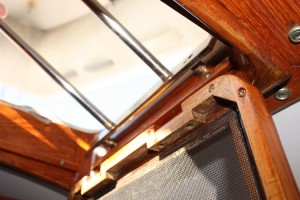

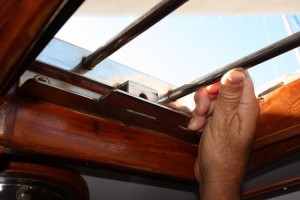
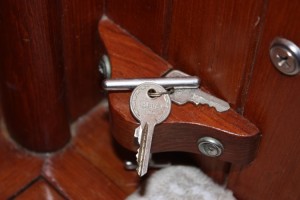
The fabricator recommended we use Abus disc locks which we did – no use to go to the trouble of fabricating nice stainless safety bars if a simple snip of a lock could allow someone access.
Also, be sure to think through your companionway access. We happen to have an extremely heavy and sturdy teak companionway which we keep locked at night and even a bar wedging it from underneath so no one could just push it open to come in while we’re inside sleeping. We know most cruisers sleep with their companionways open and so do we most of the time, but not always and we like having the option.
We don’t recommend or not recommend you add safety bars to your boat. It’s each cruisers responsibility to be comfortable with what works for them – just as it’s each cruisers responsibility to determine weather and passage safety. But we can say we’ve never been sorry we added the security bars.
If anyone has questions or other ways they’ve created security bars, please share with everyone! Cheers! Jan
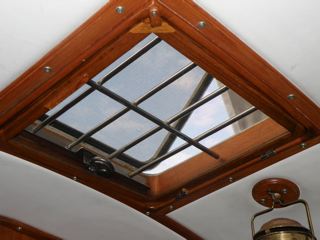












I was speaking with a friend of mine who also suggested putting in a “safe room” area such as a shower stall lined with kevlar matting and a thick bullit proof clear locking door with an emergency oxygen tank to lock yourself into if they get passed the bars to give yourself more time while trying to communicate for help. It would be an expensive but light weight conversion. Would that be going too far though??
WoW! I’ve never heard of anyone going that far, although I have heard of cruisers actually being boarded, mostly in places that local knowledge said were questionable. Our experience is primarily opportunity theft.
Many years ago, in the ‘20,000 Leagues under the Sea’ movie, Captain Nemo had rigged the deck of the Nautilus to be electrified and shocked the native burglar/pirate boarders till they jumped off!
Couldn’t you rig an electric ‘Cattle or Horse’ electrified fence into your stanchion safety lines to thwart the pirates?
LOL
Paul, I see the ‘Electric Fence’ yacht defense mentioned by many Yachties as a possibility, but have yet to see it implemented by anyone. I forsee a few problems which may be dissuading owners from trying it.
Electrifying the lifelines, stancions or other superstructure and fittings could fry the shit out of your boats electrical system, and or batteries for one.
Another problem is electrolysis. Running current through a boat in a questionable manner while it is sitting in a saltwater environment could disintegrate any less noble metals rather quickly, so you may find that you are burning through your Anodes or Zincs more quickly than you are depleting your stock of beers. Rather expensive!
I’m not saying that it cannot be done, but there are several Boat Killing problems to work through before attempting such an experiment, and while you or I might manage to figure out how to get it working on our ‘Particular’ boat, it is easy to understand that just about every boat is constructed and wired differently, so what works on my boat may be a ticking time bomb of electrical shutown, instrument fry, or cause an electrical fire on your boat.